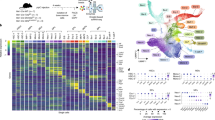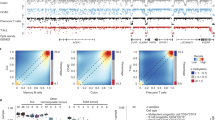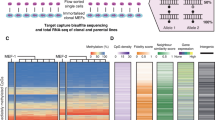Abstract
Gains and losses in DNA methylation are prominent features of mammalian cell types. To gain insight into the mechanisms that promote shifts in DNA methylation and contribute to changes in cell fate, including malignant transformation, we performed genome-wide mapping of 5-methylcytosine and 5-hydroxymethylcytosine in purified mouse hematopoietic stem cells. We discovered extended regions of low methylation (canyons) that span conserved domains frequently containing transcription factors and are distinct from CpG islands and shores. About half of the genes in these methylation canyons are coated with repressive histone marks, whereas the remainder are covered by activating histone marks and are highly expressed in hematopoietic stem cells (HSCs). Canyon borders are demarked by 5-hydroxymethylcytosine and become eroded in the absence of DNA methyltransferase 3a (Dnmt3a). Genes dysregulated in human leukemias are enriched for canyon-associated genes. The new epigenetic landscape we describe may provide a mechanism for the regulation of hematopoiesis and may contribute to leukemia development.
This is a preview of subscription content, access via your institution
Access options
Subscribe to this journal
Receive 12 print issues and online access
$209.00 per year
only $17.42 per issue
Buy this article
- Purchase on Springer Link
- Instant access to full article PDF
Prices may be subject to local taxes which are calculated during checkout





Similar content being viewed by others
References
Bird, A., Taggart, M., Frommer, M., Miller, O.J. & Macleod, D. A fraction of the mouse genome that is derived from islands of nonmethylated, CpG-rich DNA. Cell 40, 91–99 (1985).
Irizarry, R.A. et al. The human colon cancer methylome shows similar hypo- and hypermethylation at conserved tissue-specific CpG island shores. Nat. Genet. 41, 178–186 (2009).
Ley, T.J. et al. DNMT3A mutations in acute myeloid leukemia. N. Engl. J. Med. 363, 2424–2433 (2010).
Yan, X.J. et al. Exome sequencing identifies somatic mutations of DNA methyltransferase gene DNMT3A in acute monocytic leukemia. Nat. Genet. 43, 309–315 (2011).
Delhommeau, F. et al. Mutation in TET2 in myeloid cancers. N. Engl. J. Med. 360, 2289–2301 (2009).
Abdel-Wahab, O. et al. Genetic characterization of TET1, TET2, and TET3 alterations in myeloid malignancies. Blood 114, 144–147 (2009).
Lister, R. et al. Human DNA methylomes at base resolution show widespread epigenomic differences. Nature 462, 315–322 (2009).
Stadler, M.B. et al. DNA-binding factors shape the mouse methylome at distal regulatory regions. Nature 480, 490–495 (2011).
Ziller, M.J. et al. Genomic distribution and inter-sample variation of non-CpG methylation across human cell types. PLoS Genet. 7, e1002389 (2011).
Hodges, E. et al. Directional DNA methylation changes and complex intermediate states accompany lineage specificity in the adult hematopoietic compartment. Mol. Cell 44, 17–28 (2011).
Gardiner-Garden, M. & Frommer, M. CpG islands in vertebrate genomes. J. Mol. Biol. 196, 261–282 (1987).
Lowe, C.B., Bejerano, G. & Haussler, D. Thousands of human mobile element fragments undergo strong purifying selection near developmental genes. Proc. Natl. Acad. Sci. USA 104, 8005–8010 (2007).
Hendrix, D.A., Hong, J.W., Zeitlinger, J., Rokhsar, D.S. & Levine, M.S. Promoter elements associated with RNA Pol II stalling in the Drosophila embryo. Proc. Natl. Acad. Sci. USA 105, 7762–7767 (2008).
Bellen, H.J. et al. The Drosophila gene disruption project: progress using transposons with distinctive site specificities. Genetics 188, 731–743 (2011).
Akalin, A. et al. Transcriptional features of genomic regulatory blocks. Genome Biol. 10, R38 (2009).
Kikuta, H. et al. Genomic regulatory blocks encompass multiple neighboring genes and maintain conserved synteny in vertebrates. Genome Res. 17, 545–555 (2007).
Whyte, W.A. et al. Master transcription factors and mediator establish super-enhancers at key cell identity genes. Cell 153, 307–319 (2013).
Wilson, N.K. et al. Combinatorial transcriptional control in blood stem/progenitor cells: genome-wide analysis of ten major transcriptional regulators. Cell Stem Cell 7, 532–544 (2010).
Bernstein, B.E. et al. A bivalent chromatin structure marks key developmental genes in embryonic stem cells. Cell 125, 315–326 (2006).
Stadler, M.B. et al. DNA-binding factors shape the mouse methylome at distal regulatory regions. Nature 480, 490–495 (2011).
Coolen, M.W. et al. Consolidation of the cancer genome into domains of repressive chromatin by long-range epigenetic silencing (LRES) reduces transcriptional plasticity. Nat. Cell Biol. 12, 235–246 (2010).
Bert, S.A. et al. Regional activation of the cancer genome by long-range epigenetic remodeling. Cancer Cell 23, 9–22 (2013).
Patel, J.P. et al. Prognostic relevance of integrated genetic profiling in acute myeloid leukemia. N. Engl. J. Med. 366, 1079–1089 (2012).
Challen, G.A. et al. Dnmt3a is essential for hematopoietic stem cell differentiation. Nat. Genet. 44, 23–31 (2012).
Pastor, W.A., Aravind, L. & Rao, A. TETonic shift: biological roles of TET proteins in DNA demethylation and transcription. Nat. Rev. Mol. Cell Biol. 14, 341–356 (2013).
Inoue, A. & Zhang, Y. Replication-dependent loss of 5-hydroxymethylcytosine in mouse preimplantation embryos. Science 334, 194 (2011).
Pastor, W.A. et al. Genome-wide mapping of 5-hydroxymethylcytosine in embryonic stem cells. Nature 473, 394–397 (2011).
Booth, M.J. et al. Quantitative sequencing of 5-methylcytosine and 5-hydroxymethylcytosine at single-base resolution. Science 336, 934–937 (2012).
Roller, A. et al. Landmark analysis of DNMT3A mutations in hematological malignancies. Leukemia 27, 1573–1578 (2013).
Jones, P.A. & Baylin, S.B. The epigenomics of cancer. Cell 128, 683–692 (2007).
Long, H.K. et al. Epigenetic conservation at gene regulatory elements revealed by non-methylated DNA profiling in seven vertebrates. eLife 2, e00348 (2013).
Xie, W. et al. Epigenomic analysis of multilineage differentiation of human embryonic stem cells. Cell 153, 1134–1148 (2013).
Ko, M. et al. Impaired hydroxylation of 5-methylcytosine in myeloid cancers with mutant TET2. Nature 468, 839–843 (2010).
Goodell, M.A., Brose, K., Paradis, G., Conner, A.S. & Mulligan, R.C. Isolation and functional properties of murine hematopoietic stem cells that are replicating in vivo. J. Exp. Med. 183, 1797–1806 (1996).
Mayle, A., Luo, M., Jeong, M. & Goodell, M.A. Flow cytometry analysis of murine hematopoietic stem cells. Cytometry A 83, 27–37 (2013).
Gu, H. et al. Preparation of reduced representation bisulfite sequencing libraries for genome-scale DNA methylation profiling. Nat. Protoc. 6, 468–481 (2011).
Huang, Y., Pastor, W.A., Zepeda-Martinez, J.A. & Rao, A. The anti-CMS technique for genome-wide mapping of 5-hydroxymethylcytosine. Nat. Protoc. 7, 1897–1908 (2012).
Krueger, F. & Andrews, S.R. Bismark: a flexible aligner and methylation caller for Bisulfite-Seq applications. Bioinformatics 27, 1571–1572 (2011).
Dahl, J.A. & Collas, P. A rapid micro chromatin immunoprecipitation assay (microChIP). Nat. Protoc. 3, 1032–1045 (2008).
Xi, Y. & Li, W. BSMAP: whole genome Bisulfite Sequence MAPping program. BMC Bioinformatics 10, 232 (2009).
Lin, X. et al. BSeQC: quality control of bisulfite sequencing experiments. Bioinformatics 10.1093/bioinformatics/btt548 (11 October 2013).
Zhang, Y. et al. Model-based analysis of ChIP-Seq (MACS). Genome Biol. 9, R137 (2008).
Li, R. et al. SOAP2: an improved ultrafast tool for short read alignment. Bioinformatics 25, 1966–1967 (2009).
He, Y.-F. et al. Tet-mediated formation of 5-carboxylcytosine and its excision by TDG in mammalian DNA. Science 333, 1303–1307 (2011).
Robinson, M.D., McCarthy, D.J. & Smyth, G.K. edgeR: a Bioconductor package for differential expression analysis of digital gene expression data. Bioinformatics 26, 139–140 (2010).
Kuhn, A., Luthi-Carter, R. & Delorenzi, M. Cross-species and cross-platform gene expression studies with the Bioconductor-compliant R package 'annotationTools'. BMC Bioinformatics 9, 26 (2008).
Simon, R. et al. Analysis of gene expression data using BRB-ArrayTools. Cancer Inform. 3, 11–17 (2007).
Eisen, M.B., Spellman, P.T., Brown, P.O. & Botstein, D. Cluster analysis and display of genome-wide expression patterns. Proc. Natl. Acad. Sci. USA 95, 14863–14868 (1998).
Acknowledgements
We thank T. Chen, J.P. Issa, J. Gilbert and members of the Goodell laboratory for helpful discussions. This work was supported by US National Institutes of Health (NIH) grants AG036562, CA126752, DK092883, CA125123, DK084259 and AI07495, the Ellison Medical Foundation, Cancer Prevention Research Institute of Texas (CPRIT) grant RP110028 and the Samuel Waxman Foundation (M.A.G.): by CPRIT RP110471, NIH grant RO1HG007538 and DOD PC094421 (W.L.); and by grants CA151535 and CIRM RM1-01729 and Leukemia and Lymphoma Society award 6187-12 (A.R.). Y.H. and M.K. are supported by Leukemia and Lymphoma Society fellowships.
Author information
Authors and Affiliations
Contributions
M.J., M.L., G.A.C., X.Z., Y.H., M.K., H.W., L.Y. and R.C. designed and performed experiments. M.J., D.S., M.L., G.A.C., B.R., L.C., S.-B.K., R.H., L.A.G., A.R., G.J.D., W.L. and M.A.G. analyzed data. M.J., D.S., M.L., G.A.C., B.R., J.-S.L., B.G., P.G., L.A.G., G.J.D., A.R., W.L. and M.A.G. wrote and edited the manuscript.
Corresponding authors
Ethics declarations
Competing interests
The authors declare no competing financial interests.
Supplementary information
Supplementary Text and Figures
Supplementary Figures 1–12 (PDF 2094 kb)
Supplementary Table 1
Whole-genome sequencing statistics (XLSX 12 kb)
Supplementary Table 2
UMRs in WT HSCs (XLSX 3111 kb)
Supplementary Table 3
UMRs in HOX genes (XLSX 42 kb)
Supplementary Table 4
UMRs in ESCs (XLSX 1819 kb)
Supplementary Table 5
Canyons versus UMRs (XLSX 13 kb)
Supplementary Table 6
WT versus Dnmt3a KO HSC UMRs (XLSX 9021 kb)
Supplementary Table 7
5hmC sites in WT and Dnmt3a KO (XLSX 21506 kb)
Supplementary Table 8
oxBS sequencing (XLSX 21 kb)
Supplementary Table 9
Summary of genes overlapping leukemia Oncomine signatures (XLSX 246 kb)
Rights and permissions
About this article
Cite this article
Jeong, M., Sun, D., Luo, M. et al. Large conserved domains of low DNA methylation maintained by Dnmt3a. Nat Genet 46, 17–23 (2014). https://doi.org/10.1038/ng.2836
Received:
Accepted:
Published:
Issue Date:
DOI: https://doi.org/10.1038/ng.2836
This article is cited by
-
Excess folic acid intake increases DNA de novo point mutations
Cell Discovery (2023)
-
DNMT3B supports meso-endoderm differentiation from mouse embryonic stem cells
Nature Communications (2023)
-
A comparative methylome analysis reveals conservation and divergence of DNA methylation patterns and functions in vertebrates
BMC Biology (2022)
-
Targeting the histone H3 lysine 79 methyltransferase DOT1L in MLL-rearranged leukemias
Journal of Hematology & Oncology (2022)
-
The disordered N-terminal domain of DNMT3A recognizes H2AK119ub and is required for postnatal development
Nature Genetics (2022)



